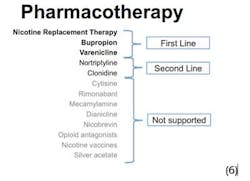On October 17, 2014, at the National Center for Dental Hygiene Research and Practice (NCDHRP) Conference, Charl Els, MBChB, FCPsych (SA), MMedPsych (cum laude), Dip ABAM, MROCC,presented “Interrupting the Disease of Tobacco Addiction.”
Dr. Charl Els, pictured left, is Associate (adjunct) Professor, Dossetor Health Ethics Centre Associate Clinical Professor, Department of Psychiatry, Faculty of Medicine and Dentistry. The goals of the course were to provide participants with an increased knowledge of the disease of tobacco addiction, greater confidence in applying the clinical practice guidelines, and enhanced skills in approaching tobacco addicted patients.
Dr. Els began by stating that there are 480,000 deaths every year due to tobacco in the U.S.(2), and he said there is a large number of smokers in the mental health community. He told the story of a 68-year-old woman who had paranoid schizophrenia, and she was given a 15-minute break to smoke a cigarette outside the Alberta Hospital Edmonton mental health facility on Dec. 3, 2008. She disappeared and was not found until eight days later, frozen next to an isolated abandoned building on the hospital grounds.(3)
Dr. Els discussed the health consequences causally linked to smoking and secondhand smoke. He reviewed the differences between a normal brain and an addicted brain (as shown on scans). He referenced the USDHHS Guidelines: Treating Tobacco Use and Dependence.(4) As we know, this is the 50th anniversary of the Surgeon General’s Report on Smoking and Health.
Pharmacotherapy was also discussed, along with nicotine withdrawal symptoms. He reviewed evidence-based statements from a Cochrane review. One statement he made is that Nicotine Replacement Therapy (NRT), bupropion, and varenicline improve the odds ratio (OR) of quitting with a low risk of harm. The authors concluded that NRT, bupropion, varenicline, and cytisine have been shown to improve the chances of quitting. The combination NRT and varenicline are equally effective as cessation tools, and nortriptyline improves the chances of stopping tobacco use. The treatments that were studied appear to be safe with little or no occurrence of adverse events. Further research is warranted into the safety of varenicline and cytisine's potential as an effective and affordable treatment, but not into the efficacy and safety of NRT.(5)
Negotiating behavior change is part of tobacco cessation. Health-care practitioners must have an information exchange, reduce resistance, and build confidence. Knowing when someone is ready to change is vital. Motivational interviewing (MI) is an approach to improve adherence.(7) There are many resources for MI.(8)
We must also be aware of comorbidities, such as depression, in relation to tobacco use. Current smokers are about 26% of the general population, but 56% of the depressed population.(6) Suicide risk is also higher in smokers. Dr. Els referenced the guidelines for implementation of the WHO Framework Convention on Tobacco Control.(9)
References
1. https://www.nicotinedependenceclinic.com/English/teach/SiteAssets/Pages/FAQ/TEACH%20FAQ.pdf.
2. http://www.cdc.gov/tobacco/data_statistics/fact_sheets/health_effects/tobacco_related_mortality/.
3. http://www2.canada.com/calgaryherald/news/city/story.html?id=49dd4611-4fce-4403-860d-9650b9d69054&p=1.
4. http://www.surgeongeneral.gov/initiatives/tobacco/index.html.
5. Cahill K, Stevens S, Perera R, Lancaster T. Pharmacological interventions for smoking cessation: an overview and network meta-analysis. Cochrane Database Syst Rev. 2013 May 31;5:CD009329. doi: 10.1002/14651858.CD009329.pub2.
6. Els C. Interrupting the Disease of Tobacco Addiction-course. October 17, 2014, Bethesda, MD.
7. http://www.adultmeducation.com/downloads/adult_med_facilitating.pdf.
8. http://www.motivationalinterview.org/Documents/bib/rollnick.miller.pdf.
9. http://apps.who.int/iris/bitstream/10665/80510/1/9789241505185_eng.pdf.
10. http://www.smartalarmchoices.org/
Maria Perno Goldie, RDH, MS, is the editorial director of RDH eVillage FOCUS.












